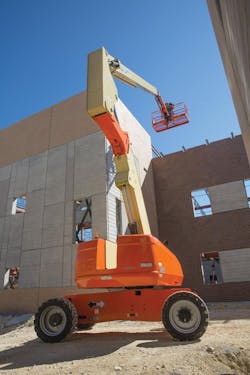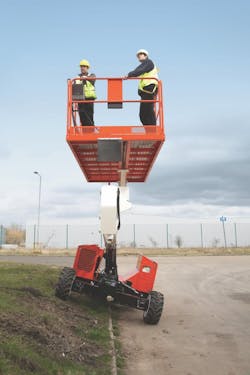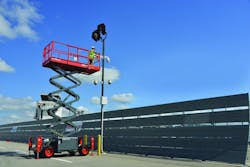New Standards, Technical Advances for MEWPs
On a global basis, mobile elevating work platforms (MEWPs)—whether telescopic-boom, articulating-boom, scissor, vertical-mast, or trailer-mounted—are big business. According to JCB, the most recent manufacturer to enter the market and aiming to have 27 MEWP models in its Access business by year’s end, global sales at present amount to some 130,000 units annually in an $8-billion market. An estimated 80 to 95 percent of these models will be placed in rental fleets.
The new JCB MEWPs, says Richard Butler, managing director for JCB Access, are designed in-house, will initially be available in the UK, France, Germany, and North America, and will comply with the latest ANSI and CSA standards.
The standards JCB references are, in fact, new North American regulations that govern the design, safe use, and training requirements associated with these machines, which are now classified by group (A or B) and type (1, 2, or 3). (See Construction Equipment’s August 2016 issue, page 36, for category descriptions.)
Canada has already published its new regulations under CSA Group (formerly the Canadian Standards Association) B354.6/7/8 standards, and in the United States, the new ANSI/SAIA (American National Standards Institute/Scaffold & Access Industry Association) A92.20/22/24 standards are expected to be published by year-end 2017. According to Paul Kreutzwiser, JLG Industries’ global category director for aerial work platforms, manufacturers have one year to comply with required changes once new standards are published.
“Most machines will monitor loads and will not operate if overloaded beyond rated capacity,” says Greenaway, “and platform controls must be protected from inadvertent operation. New wind-force stipulations likely will increase weight and reduce capacities for outdoor machines, and new stability-testing requirements generally mean that rough-terrain boom and rough-terrain scissor models will be restricted to using foam-filled tires.
“Gates with toe boards replace chain entrances on electric scissor and vertical-lift models, and toe boards are required at the entrance on booms. Compact electric scissors will mainly be equipped with folding—not fixed—rails, due to a 4-inch increase in railing heights.”
JLG’s Kreutzwiser expands on the requirement for control-protection, adding that hand-operated controls on the platform must be guarded to prevent “sustained involuntary operation.” The intent is to prevent trapping the operator between the machine and an obstruction if controls are inadvertently activated.
Guarding systems already developed for this purpose typically place an unobtrusive, pressure-sensitive barrier (bar or cable) above the controls, and when pressure is exerted on the barrier, the system stops (or stops and reverses) machine movement and sets off alarms. Proprietary systems include JLG’s SkyGuard, Genie’s Lift Guard Contact Alarm, Snorkel’s Snorkel Guard, and Skyjack’s Secondary Guarding System. According to JCB’s Butler, the company will make its proprietary system a standard feature on all boom models as they are released.
Regarding the load-sensing capability of new North American MEWPs, Chad Hislop, Genie director of engineering, Terex AWP, reminds users that the system offers protection against more than just placing too much weight in the platform. The system also affords protection, he says, when the operator inadvertently adds weight to a raised platform by allowing it to crowd, say, a building’s window ledge or the beam of a nearby structure. Operators must be trained to properly resolve these overload conditions, says Hislop.
Matthew Elvin, CEO, Snorkel, explains that the new ANSI/SAIA and CSA Group regulations are based on the ISO (International Organization for Standardization) 16368 standard, which is the reference for the established European standard (EN280) and the Australian standard (AS1418.10). The goal of the new North American regulations, says Elvin, is to bring global uniformity to the design and use of MEWPs.
For MEWP manufacturers conducting business on a global basis, as most are, the new regulations are familiar.
“Snorkel has been producing aerial work platforms that comply with EN280 and AS1418.10 for nearly two decades,” says Elvin, “so the machines we now build to the ANSI standard will be the same that we build for these other national standards.”
Says Skyjack’s Greenaway, “Could be a challenging adoption phase for the first few years, while rental companies operate a mixed fleet of units. It will be difficult to avoid the scenario of one job site having two versions of the same model, each with different capabilities and restrictions. As manufacturers, we have a great deal to do in helping support fleet managers, rental-desk staff, end users, and supervisors during this transition phase.”
Training
“Training requirements will be different with the new standards,” says Scott Owyen, Genie training manager, Terex AWP, “and it’s important that users understand the more significant changes, because some are specific to ANSI only or to CSA only, while others are shared by the two standards.”
According to Owyen, MEWP users should be particularly aware of changes in training requirements in four key areas: safe-use planning; supervisor training; occupant training; and maintenance/repair personnel training.
For example, a major addition to the ANSI standard, he says, is the requirement for users to ensure that all personnel directly supervising MEWP operators are adequately trained in critical areas. New for Canada’s standards is the requirement for users to ensure that maintenance people are trained by a qualified person to follow the manufacturer’s inspect/maintenance procedures.
In both ANSI and CSA Group standards, says Owyen, occupant training is required. The operator must ensure that all occupants on the platform know how to use fall protection, have a basic knowledge of safe working procedures and potential hazards for the activity at hand, and be aware of activities that can affect machine stability. Also, at least one occupant must be instructed about how to safely lower the platform to the ground in an emergency.
MEWP design trends
One wonders if MEWP manufacturers might feel somewhat challenged when, on the one hand, they’re adding machine weight and reducing capacities in the interest of stability and wind-resistance, while, on the other, trying to meet customer demand for units with increased all-around capabilities. But, obviously, manufacturers are equal to the task.
According to Genie’s Hislop, the industry also is seeing increasing need for MEWPs that allow working safely at greater heights, while also handling increased loads to reducing the number of lift cycles required. To that end, he says, Genie has developed a line of Xtra Capacity (XC) boom models, which use a dual-envelope design to provide an unrestricted platform capacity of 660 pounds and a restricted capacity of 1,000 pounds.
Skyjack’s Greenaway says capacity and speed were design goals for the new SJ85 AJ, the largest articulating-boom model in the Skyjack range, with a platform height of 85 feet and an up-and-over clearance of 34 feet. The machine has a dual-capacity rating (500/750 pounds) and features an “open-knuckle” riser design, which, says Greenaway, allows the SJ85 AJ to attain full lift in about 60 seconds and to lower the fly boom to ground level without lowering the riser.
“Contractors, rental companies, and technicians also are calling for simplified serviceability,” says JLG’s Kreutzwiser, “and ease-of-transport concerns are shifting the design of articulating-boom models towards units that fit on a standard flatbed trailer without requiring an over-size-load permit.”
JCB Access’s Butler makes the point that the company’s new models are “designed specifically to meet the demands of work platform users,” and notes particular features of the company’s scissor models, including a zero inside turn radius to facilitate positioning in confined spaces, control cradle designed for use by right- or left-handed operators, intuitive operation of basket doors for ease of ingress/egress, and an outdoor rating on 15- and 19-foot models on a 30-inch chassis.
Snorkel’s Elvin sees technical advancement in several areas, including more efficient engine-mounted generators for high-power applications, such as welding, proportional throttle control for reduced noise and fuel consumption, and the development of secondary guarding systems, mechanical and electronic, which, he says, are now mandatory on many job sites around the world.
AWP energy systems
“Power systems for aerial work platforms continue to evolve, just like the machines they drive,” says Genie’s Hislop. “Wasn’t long ago that power selection was simple: ‘Give me a diesel engine for outdoor applications and battery power for working indoors.’”
As manufacturers adapt to changing markets and contractor needs, says Hislop, power-system development has kept pace. Advanced battery technology, more-efficient diesel engines, and dual-fuel engines, along with new “bi-energy” and hybrid systems (available for select models), are included among today’s power-system choices.
Bi-energy systems might use an on-board generator for stand-alone charging of the batteries, such as the system in Skyjack’s SJ6832RTE rough-terrain scissor, or they might use a diesel-powered motor-generator to charge batteries during operation, or, in some instances, to assist in driving the hydraulic pumps. Some bi-energy systems, such as that offered by Snorkel, allow the diesel to be used independent of battery power.
“The Snorkel bi-energy option delivers the benefits of both electric and diesel power in the same machine,” says Elvin. “The operator can switch from 100 percent diesel power for use outdoors or on challenging terrain, to battery power for use indoors or to meet emissions and noise regulations. The system provides flexibility—not only for operators to perform multiple tasks on the job site, but also for rental companies, allowing them to appeal to a larger customer base for improved fleet utilization.”
“Should the operator fully discharge the batteries when not working in the hybrid mode,” he says, “the machine can operate any function on engine power while the batteries are charging. For an extra-performance boost, the engine/generator system and the battery system can work together. The machine also has a regenerative braking system that sends energy back to the batteries.”
According to JLG, its new articulating-boom H800AJ uses “parallel hybrid technology,” which incorporates an engine-driven motor-generator to charge the unit’s batteries on demand and also to assist in driving the hydraulic pumps. The machine can run exclusively in an electric mode via its battery pack located in the counterweight.
“As demand increases across the equipment industry for eco-friendly products,” says JLG’s Kreutzwiser, “the industry will continue to see hybrid innovation and expansion, as well as new technology for different applications, product categories, and fuel types.”



